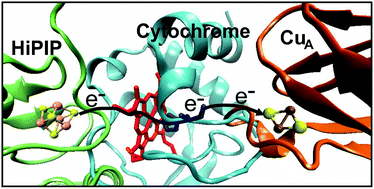Electron transfer dynamics of Rhodothermus marinus caa3 cytochrome c domains on biomimetic films†
Abstract
The subunit II of the caa3 oxygen reductase from Rhodothermus marinus contains, in addition to the CuA center, a c-type

* Corresponding authors
a
Departamento de Química Inorgánica, Analítica y Química Física and INQUIMAE (CONICET-UBA), Facultad de Ciencias Exactas y Naturales, Universidad de Buenos Aires, Ciudad Universitaria, Pab. 2, piso 1, C1428EHA-Buenos Aires, Argentina
E-mail:
dhmurgida@qi.fcen.uba.ar
b Departamento de Química Orgánica and UMYMFOR (CONICET-FCEyN), Facultad de Ciencias Exactas y Naturales, Universidad de Buenos Aires, Ciudad Universitaria, Pab. 2, piso 3, C1428EHA-Buenos Aires, Argentina
c
Instituto de Tecnologia Química e Biológica, Universidade Nova de Lisboa, Av. República (EAN), 2780-157 Oeiras, Portugal
E-mail:
smilja@itqb.unl.pt
The subunit II of the caa3 oxygen reductase from Rhodothermus marinus contains, in addition to the CuA center, a c-type

 Please wait while we load your content...
Something went wrong. Try again?
Please wait while we load your content...
Something went wrong. Try again?
M. F. Molinas, A. De Candia, S. H. Szajnman, J. B. Rodríguez, M. Martí, M. Pereira, M. Teixeira, S. Todorovic and D. H. Murgida, Phys. Chem. Chem. Phys., 2011, 13, 18088 DOI: 10.1039/C1CP21925A
To request permission to reproduce material from this article, please go to the Copyright Clearance Center request page.
If you are an author contributing to an RSC publication, you do not need to request permission provided correct acknowledgement is given.
If you are the author of this article, you do not need to request permission to reproduce figures and diagrams provided correct acknowledgement is given. If you want to reproduce the whole article in a third-party publication (excluding your thesis/dissertation for which permission is not required) please go to the Copyright Clearance Center request page.
Read more about how to correctly acknowledge RSC content.
 Fetching data from CrossRef.
Fetching data from CrossRef.
This may take some time to load.
Loading related content
